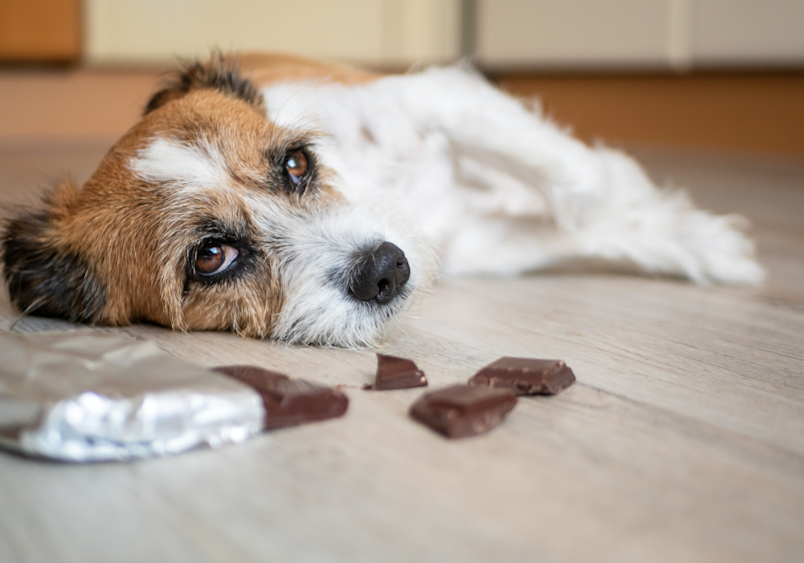
Dogs have an uncanny ability to sniff out and devour chocolate in its many tempting forms—dark, milk, white, or mocha. Their love for this treat is undeniable, but so is the danger it poses. You likely know by now that chocolate can be toxic to dogs, but do you understand why? Let’s delve into the science behind chocolate toxicity in our canine companions.
What Makes Chocolate Poisonous to Dogs?
Chocolate toxicity in dogs is primarily caused by two compounds: theobromine and caffeine, both of which belong to a class of chemicals known as methylxanthines. These methylxanthines act as stimulants in dogs, affecting their heart rate, central nervous system, and even their urinary system. Here is why these compounds are so problematic for our furry friends:
Theobromine: This is the primary toxic component in chocolate for dogs. It is a bitter alkaloid of the cacao plant, similar in structure to caffeine. Dogs metabolize theobromine much more slowly than humans do. While we can process it in 2-3 hours, it can take up to 18 hours for a dog to clear it from their system, thus building up to toxic levels.
Caffeine: Although less concentrated than theobromine in chocolate, caffeine contributes to the overall toxic effect. Like theobromine, dogs struggle to metabolize caffeine efficiently, further exacerbating the effects when combined with theobromine.
Why Can't Dogs Process Chocolate Like Humans?
The key difference lies in how dogs and humans metabolize theobromine and caffeine. Humans can process and excrete theobromine quickly because we possess enzymes that can rapidly break down and eliminate these compounds from the body. Dogs, on the other hand, lack these efficient enzymes, making the process much slower and thereby causing the toxins to linger in their system much longer.
This slower processing is what makes chocolate that is safe for humans potentially deadly for dogs. It is not that chocolate contains something uniquely toxic to dogs, but rather that dogs cannot efficiently clear these compounds from their bodies.
What about Cats?
While dogs often dominate discussions about chocolate toxicity, it is important to consider the risks for cats. Despite them being less drawn to chocolate due to their inability to taste sweetness and generally selective eating habits, some felines still fall for the allure of desserts like creamy chocolate pies, unknowingly exposing themselves to serious health hazards.
Not to mention that cats have a lower tolerance for chocolate compared to dogs, primarily due to their smaller body size. Even small amounts of white chocolate can also be harmful due to its high fat content and can lead to significant health issues in cats.
If your cat does eat chocolate, be aware of the potential symptoms of poisoning. These include:
Vomiting
Diarrhea
Lethargy (lack of energy)
Increased thirst and urination
Muscle tremors
Seizures
Left untreated, chocolate poisoning can be fatal for cats.
If you suspect your cat has eaten chocolate, contact your veterinarian immediately. The vet will be able to assess the situation based on the type and amount of chocolate ingested, your cat's size, and the time elapsed since consumption. Early intervention is crucial for a full recovery.
Types of Chocolate and Their Toxicity Levels
The amount of caffeine and theobromine in chocolate varies with the type of chocolate. The general rule is the more bitter the chocolate, the more caffeine and theobromine it is likely to contain. For example, unsweetened baking chocolate contains almost seven times more theobromine than milk chocolate.
Here is a Breakdown of Chocolate Types from Most Toxic to Least Toxic for Dogs:
Cocoa powder and unsweetened baker's chocolate contain the highest concentrations of theobromine and are therefore the most toxic.
Dark chocolate and semisweet chocolate also contain significant levels of theobromine.
Milk chocolate, while less toxic, can still cause harm if ingested in large quantities due to its lower but still present theobromine content.
White chocolate, although containing only trace amounts of theobromine and caffeine, is high in fat and can lead to other health issues like pancreatitis.

How Much Chocolate is Dangerous?
The toxicity of chocolate depends on several factors including the type of chocolate, the amount consumed, and the size of the dog. Understanding how much chocolate can kill a dog and why chocolate is bad for dogs is crucial for pet owners. Here is a general guideline:
Even small amounts of dark chocolate or cocoa powder can cause severe symptoms in dogs. Never assume that any amount is safe.
For milk chocolate, ingestion of approximately 1 ounce (about 28.35 g) per pound of body weight could be lethal.
Dark chocolate is much more potent, with as little as 0.1 ounces (about 2.83 g) per pound of body weight capable of causing serious health issues.
Additional Health Risks from Chocolate
Beyond theobromine and caffeine, chocolate poses other health risks to dogs:
High fat content: Can lead to pancreatitis, a serious and potentially life-threatening condition.
Sugar: Can contribute to obesity and dental problems.
Xylitol: Some sugar-free chocolates contain this artificial sweetener, which is extremely toxic to dogs.
Symptoms of Chocolate Toxicity in Dogs
Clinical signs of chocolate toxicosis can begin to occur within an hour of ingestion, although onset may be delayed if the pet has recently eaten with a full stomach. To reiterate, both caffeine and theobromine act as stimulants affecting the brain and heart, resulting in initial symptoms of chocolate poisoning in dogs. These initial symptoms often include hyperactivity, restlessness, and increased heart rate. However, these early signs can be subtle and easily overlooked by even the most attentive pet owners.
The first noticeable symptom for pet parents is usually vomiting, followed by diarrhea, excessive thirst, and frequent urination. As the condition progresses, dogs may exhibit more severe signs such as muscle tremors, panting, anxiety, and uncoordinated movements. In serious cases, chocolate toxicity can lead to seizures, cardiac arrhythmias, hyperthermia, and rapid breathing. These severe symptoms are red flags that require immediate veterinary attention.
Complications associated with chocolate toxicosis, especially without prompt treatment, can easily escalate to heart failure, coma, and even death as quickly as 24 hours after ingestion! This is not a situation where you want to wait a few days and gauge how the pet does.
What to Do If Your Dog Eats Chocolate
If chocolate ingestion is suspected, contact a veterinarian immediately! Be ready to provide some basic info: your pet's weight, the type of chocolate eaten, when it was consumed, and an estimate of the amount of chocolate eaten. Even if you are not exactly sure of amounts, you can use a dog chocolate toxicity meter to calculate estimates and find out if your pet has ingested anywhere near a dangerous amount of toxic ingredients. However, it is still best to talk to your veterinarian to determine the appropriate course of action.
Treatment for Chocolate Poisoning May Include:
Inducing vomiting (if caught early – but is not generally advised as it can cause your pet to aspirate, or vomit some of the stomach contents into his or her trachea or lungs, which can set up brutal pneumonia.)
Administering activated charcoal, which is done by your veterinarian. This is a liquid given by mouth and limits absorption of anything in the stomach and upper intestines.
Intravenous (IV) fluids which will most likely be recommended by your veterinarian. This is to help flush the chemicals from your pet’s system.
Supportive and additional medication to control symptoms. This, however, will be administered on a case-to-case basis.
Monitoring heart rate and rhythm.
For the most uncomplicated cases of chocolate poisoning, pets will only have to stay in the hospital for a day or two. Severely affected pets may have to stay a bit longer.
Preventing Chocolate Poisoning in Pets
Prevention is always better than cure when it comes to chocolate toxicity in dogs and cats. Keep all chocolate products out of reach, especially during holidays when chocolate is more prevalent in homes. Educate all family members, especially children, about the dangers of giving chocolate to pets.
But we all know accidents can happen, right? Like that moment when you turn away for a second and suddenly find your dog munching on your favorite dark chocolate. That is where having pet insurance comes in. It covers emergencies, like mishaps on chocolate toxicity, which can save you from unexpected vet bills—who knew a little piece of chocolate could cost thousands of dollars in vet bills? So, it’s smart to have a plan in place, ready for those unexpected moments.
The takeaway? Keep chocolate out of reach of your pets! Understanding the 'why' behind chocolate's danger empowers you to protect your furry companion. It's not worth the risk, and there are plenty of delicious pet-safe treats out there to show them you care.